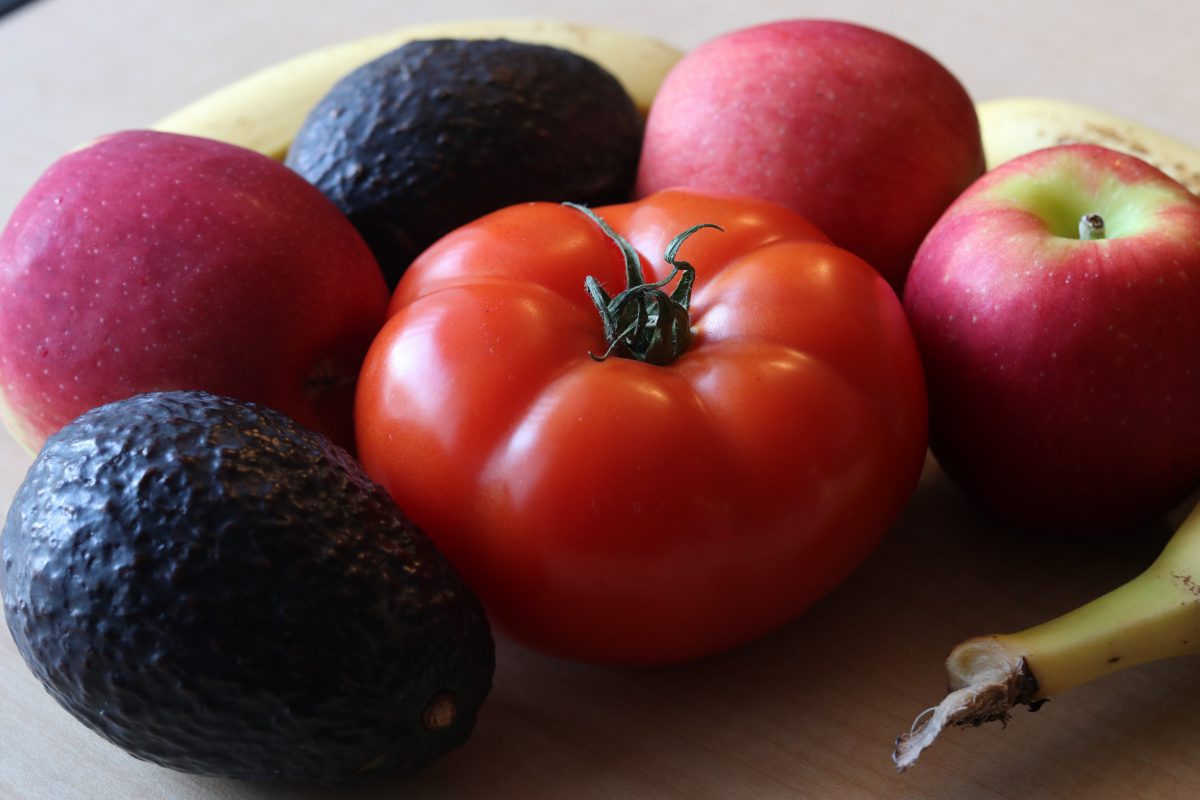“Where do you get your groceries?” wasn’t always a loaded question.
Before the mid-2000s, you weren’t expected to wonder where your supermarket apples were grown, or how they got to the supermarket. Since then, however, the local food movement has taken off. Over the last two decades, demand for locally produced fruits, vegetables and animal products has spread across the United States, prompted by a rising public interest in sustainability and works like Michael Pollan’s “The Omnivore’s Dilemma.” Shoppers are now more likely to question the origin and impact of their food and seek out local outlets.
How local is local, though? The 2008 Farm Bill states that a product may be marketed as local if “the total distance that the product is transported is less than 400 miles” from its origin. Strict “locavores” often reduce this distance to 100 miles, and neighborhood markets may reduce it even further.
The point of eating locally is often to reduce “food miles” — the distance food must travel before it is purchased or consumed. More food miles mean more fuel consumed and carbon emitted to get a given piece of produce to market, resulting in a higher environmental toll overall. Purchasing local produce also supports small, regional farms instead of large commercial operations, adding an economic incentive to shop locally.
“[It’s about] giving back to our farmers that are around here and thinking about our food coming from a mile away instead of being shipped around the world,” said Brittany Barnes, a research professional at the University of Georgia and member of local CSA Collective Harvest.
Athens is particularly well-suited to develop local food networks for a couple of reasons. First, it’s no secret that the city is one of Georgia’s hipster hubs. The arts and culture scenes here attract sustainably-minded residents, creating an ideal environment for local produce organizations to grow and thrive.
“I think Athens is really special where we actually have this beautiful system of people working together and wanting to help everybody else out,” Barnes said.
The city’s proximity to agriculture also helps boost its produce profile. According to the most recent agricultural census, there were 90 farms operating in Clarke County 2012, with another 2,604 farms operating in the surrounding counties. That puts almost 2,700 farms well within even the strictest “local” radius.
Several local organizations capitalize on these advantages, striving to connect residents to their food in a variety of ways. But shoppers are often confused by the terminology of these organizations: you probably know what a farmers market is, but what about a grocery co-op? CSA? The average shopper may be intimidated by these terms, preventing them from exploring their local food options.
In an effort to clarify Athens’ thriving local food scene, here are three ways to get local food in Athens, defined and explained.
A farmers market
It’s a familiar scene: stalls and booths line a bustling outdoor space where shoppers mill about with canvas bags. Local farmers hawk their wares, while children weave through a sea of legs. Live music and the sound of cooking demonstrations may drift across the crowd. Dogs and their owners populate the perimeter, enjoying a sandwich, drink or treat from the local food cart. It’s this spirit of community that often makes farmers markets the most recognizable local food outlet.
“You have all kinds of people here. I don’t think it’s gonna be one genre of people, it’s gonna be a little bit of everything,” Athens resident Terilee Pokoski said of the Athens Farmers Market, which she attends a few times each season.
According to the Georgia Department of Agriculture, 90 independent farmers markets operate across 49 different counties in Georgia, including three in Clarke County. The Athens Farmers Market is arguably the most popular of the three, boasting 40 vendors that offer everything from produce to pasta, honey to handmade jewelry and flowers to fresh bread. While a hub for local food, the market serves even more as a hub for community engagement.
Madi Won, a sophomore linguistics and cognitive science major at the UGA, celebrated her birthday with her first visit to the market, which takes place in Bishop Park every Saturday from late March to mid-December. Even though she could rattle off a list of reasons to shop at the farmers markets over a chain grocery store –
“less food miles, better for the community, it’s better to get stuff when it’s in season” – Won’s enthusiasm lay in the aesthetics of the place.
“Everyone looks so cute, and there are so many farms here and all of the pretty flowers,” Won said. Gesturing to a young girl, she added, “She’s wearing a flower crown; it’s cute!”
Mandy Perry has been coming to the Athens Farmers Market nearly every weekend for the past three years. Over that time, she has developed relationships with regular vendors, watching their lives change through the lens of the market.
“One of the stations, we’ve kind of seen the daughter grow up because she’s been working at the stand the whole time,” Perry said. “It’s been neat to kind of get to know people a little bit and have conversations with the people that are making your food.”
CSA
What if you still want your local produce, but without the hubbub and hassle of the farmers market? Consider CSA.
CSA, which stands for community supported agriculture, came about in the 1980s as a way to connect farmers directly to local consumers. Much like a farmers market, farmers sell in-season produce directly to community members. The CSA model, however, is a little bit different.
This model gives farmers a vital cash infusion for their farms’ leaner months. Shares are usually placed in a large box and picked up weekly, with the contents of each box varying greatly depending on the season.
“I like to be surprised,” said Vanessa Cannon, a member of Athens CSA Collective Harvest. “If there’s something in my share that I wouldn’t normally buy, it sort of encourages me to get creative with cooking.”
While enticing to some, this unpredictability often leads to food waste — if you just bought carrots at the store and this week’s box comes stocked with fresh carrots, that local produce usually ends up in the trash.
“People don’t tend to have a lot of choice in what goes into their share. They can select a size, but a lot of times, what’s in their share is just what’s available at that time,” said Lisa Merva, general manager of Collective Harvest. “We’ve gotten feedback over the years that that was something that was hard for a lot of people to work with. They really enjoyed the encouragement to eat seasonally… but at the same time, sometimes it’s not very convenient.”
Merva said that this season, Collective Harvest partnered with the web platform Harvie, which allows members to customize their weekly share via a rating system. Members receive a list of items a week in advance, allowing them to switch out produce they’re not likely to use.
This element of convenience is what draws consumers to CSA over a farmers market. The assurance of a weekly supply of fresh produce provided at a set time and location attracts professionals on a busy schedule.
“Farmers markets are hard for me to get to,” said Ronda Levitt, a medical stenographer and Collective Harvest member. “I don’t like going on Saturday mornings; I like being at home. So that’s why I like this model better.”
Collective Harvest recently introduced a four-week student share, extending the convenience of the CSA model to UGA students. Esther Cole, a sophomore undecided student, signed up after receiving an email about the program.
“It just seemed like a good way to ensure that I would have a supply of food,” Cole said. “I just paid ahead, so I know that I’m going to be able to get a certain amount of food every week.”
Where the farmers market is crowded and filled with sound, Collective Harvest’s Broad Street location is quiet, airy and tranquil on a Wednesday afternoon. The peace is only interrupted by flurries of members coming in to pick up their shares of strawberries, chard and salad mix.
Collective Harvest technically serves as a food hub, a middleman organization that manages the CSA operations of multiple farms. The organization came about in 2014 when three farms consolidated their CSA efforts and has expanded to include seven member farms.
“[CSA] takes a lot of time and coordination and effort and staffing and marketing,” Merva said. “Instead of competing with each other, [the farmers] said, ‘Let’s collaborate and combine our growing power and our resources and create a better program.’”
A grocery co-op
If a CSA program guarantees you groceries once a week, where, then, should you do your daily local shopping? Consider a grocery co-op.
“A lot of people in this community don’t know what a co-op is. That’s part of our mission, is to educate more people,” said Kara Brown, general manager of Athens food co-op Daily Groceries.
By definition, co-ops are businesses owned and operated by the people who use them. Shoppers, known as members, stock shelves, man registers and generally manage the store. The store, in turn, benefits these members rather than turning a profit. This model has changed in recent years, however — federal labor laws have tightened, causing most co-ops to move away from the member-worker structure.
Rather than restricting the co-op, Brown said that this change has actually benefited Daily Groceries.
“Before, the store was almost completely run by member-workers, which is a big co-op value,” Brown said. “But when most of your staff are member-workers, it’s hard to have reliable staff and put a lot of systems in place.”
Even though the co-op has seen a 65 percent sales increase over the last four years, it still faces its fair share of challenges.
In addition to locally grown produce and artisan goods, Daily also offers grocery-store staples: cereal, snacks, shampoo and cleaning supplies line the shelves, most of them natural or organic.
The store itself, with its landmark teal balcony and trim, combines the community feel of a farmers market with the in-and-out convenience of CSA. Children run through the aisles, while their parents greet the co-op staff with friendly smiles and familiar greetings. Even at busy times, there’s rarely a line. Shoppers come in for a few items, then head out the door with those iconic canvas bags.
Even more so than at Collective Harvest, convenience is their main draw. Every customer I spoke with came from nearby: Paige Finley, a first-year law student at UGA, was visiting her partner, who lives around the corner. Jim Rios works at The Grit, a vegetarian restaurant up the street. Gary Warenfelty, a server at fellow downtown restaurant Last Resort, lives in Normaltown, a short walk away from the co-op.
Despite the proximity, all said they would be willing to travel farther for Daily Groceries. The local interaction and higher-quality produce, they say, is worth it.
“[You] just feel like you’re supporting something bigger than yourself,” said Jaclyn Nolan, a member-owner at Daily Groceries. “I think knowing what you’re supporting makes a big difference.”
For some, “Where do you get your groceries?” is not a question of choice.
Almost 35 percent of Athens-Clarke County residents live in poverty and 22 percent are food insecure, meaning they don’t know where their next meal is coming from. Food swamps, in which fast-food outlets outnumber healthier options, exist in low-income areas throughout the county. Simply put, local produce is not an option for everyone.
Each of the three organizations above is making some effort to make eating locally a feasible option for low-income residents in Athens.
In addition to accepting SNAP benefits, the Athens Farmers Market is in the third year of its FARM Rx program. The market partners with healthcare providers to prescribe fruits and vegetables “to patients with chronic, diet-related illnesses.” Prescriptions are redeemable at the market, and the study has shown “measurable impacts on participant health.”
In one instance, the farmers market was even able to involve Collective Harvest in its FARM Rx program.
Collective Harvest also operates the Fresh Food Fund, a “financial assistance program for low-income residents.” Fund recipients pay a portion of a membership, with the remainder donated by other members and community partners.
“So far, we’ve been able to offer scholarships to everybody who has applied,” Merva said.
Similarly, Daily Groceries offers a sponsored membership for SNAP recipients — recipients can join the co-op without paying equity, with the difference made up by other member-owners.
“It’s something that we really wanted to put out there,” Brown said. “We’re doing some, but we all want to do more.”
This may be the direction the local food movement takes over the next 20 years — instead of questioning where food comes from and how it came to be there, community members may begin questioning who has access to fresh food and how best to get it to those in need.
Either way, the local food movement has proved to be more than a passing trend, and demystifying its terminology is key to increasing its presence in all communities. Once shoppers are no longer intimidated by the idea of a CSA or a co-op, they may be more likely to forgo the local Kroger and explore their neighborhood food networks.
Gemma DiCarlo is a junior majoring in journalism in the Grady College of Journalism and Mass Communication at the University of Georgia.







